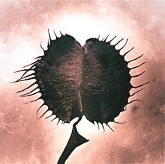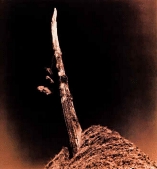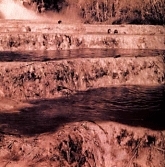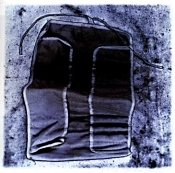|

Flytrap # 2
There are times in life when
the emotional intensity of our very own existence is such
that we can't understand art, either because the tumultuous
joy of the moment is such that we don't care to, don't
need to, or because the situation has become so dire that
we can't permit ourselves to. In both cases our attention
remains nailed fixedly to the here and now,
frustrating the Pindaric flights of art, which abandons
us, at times, just when we need her most. No longer a
vehicle of true mystic transport, art hangs up ubiquitously
in the multitude of its greater and lesser guises to fill
the dreary gaps in our humdrum lives, encouraging us to
vicariously thrill and cathartically avoid the stuff of
life's true drama.
While there has always been the real danger
of art's putting us off those humdrum lives of ours and
the "natural" world they're strutted out in
- just as the odor of cheap detergents and titillating
parfums can dampen our olfactory interest in flowers
- art's higher goal is that of preparing us for life's
true drama in the dark winter of it's thickest tedium.
Artists take us by the hand and with their, one hopes,
more highly refined sensibility, showing where to look
and how to see the transcendental beauty (or ugliness)
of the world, which ceases simply being and begins being
as.

Physik Garden # 1
For British artist Simon Larbalestier,
the natural world's "being as" entails his actively
transforming it according to the tenets of Zen Buddhism,
by which enlightenment can be attained through meditation
and intuition rather than outright devotion. He cryptically
elucidates his work with a quote from Eugen Herrigel's treatise
on the Zen method: "He is emptied of everything, yet
has no consciousness of emptiness... Seen from the outside
the medient is as if dead. Seen from the inside he is in
a state of absolute freedom (emptiness). "Larbalestier's
most recent project, entitled "Attracting to Emptiness",
is composed of several series confronting specific themes
including the forest, feet, prayer flags, and the "physik"
gardens, which were cultivated in seventeenth-century Europe
as places of healing for the mind and body, places where
special herbs and other plants were grown in particular
configurations to serve this end. "The 'Physik Garden"
series", he writes,"is more a metaphor for experience
exploring the plurality of existence, shot in the 'garden'
that actually exists, hidden in the mystic hills of Tuscany."
The viewer can hardly recognize contemporary Tuscany in
Larbalestier's images, which have been emptied out around
the isolated subjects. Whether the subject is a Buddhist
prayer flag or discarded tool bag, it's presented with the
same aesthetic attention and respectful consideration, inviting
us to contemplate it as though for the first time. His remarkable
Flytrap #2 stares back at the viewer like a beautifully
lashed human eye, portrayed in a state of petrified vigilance.
Though he doesn't shun direct human presence altogether,
Larbalestier relegates it to a condition of secondary importance:
the three heads we see in his 1998 image Sulphur Pools #2
are simply one part of a larger reality, as much as are
the ripples in the lower pools or the steam wafting away
in the background.

Sulphur Pool # 3
After graduation from London's Royal
College of Art, Larbalestier stayed on a s a research fellow
at the school's Illustration Department, exploring the graphic
applications of color photocopiers alongside the artist
Richard Caldicot, with whom he organized and jointly curated
the show "How Noisy Everything Grows," sponsored
by Canon UK and Canon Inc. Japan. Now a successful commercial
artist, in 1993 Larbalestier was commissioned by Mitchell
Beazley Publishers to research, collate and write the book
The Art and Craft of Montage. More of Larbalestier's
personal and commercial work can be seen at his website
www.simon-larbalestier.co.uk.

Toolbag
This article is © Copyright
Willis Davies 2000 and Zoom Magazine 2000. It may not
be reproduced in part or in full, in print or electronically
without permission. |